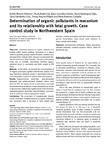Mostrar o rexistro simple do ítem
Determination of organic pollutants in meconium and its relationship with fetal growth: case control study in Northwestern Spain
| dc.contributor.author | Álvarez-Silvares, Esther | |
| dc.contributor.author | Rubio-Cid, Paula | |
| dc.contributor.author | González-Gómez, Xiana | |
| dc.contributor.author | Domínguez-Vigo, Paula | |
| dc.contributor.author | Fernández-Cruz, Tania | |
| dc.contributor.author | Seoane-Pillado, Teresa | |
| dc.contributor.author | Martínez-Carballo, Elena | |
| dc.date.accessioned | 2022-05-19T11:30:40Z | |
| dc.date.available | 2022-05-19T11:30:40Z | |
| dc.date.issued | 2021-04-14 | |
| dc.identifier.citation | Álvarez-Silvares E, Rubio-Cid P, González-Gómez X, Domínguez-Vigo P, Fernández-Cruz T, Seoane-Pillado T, et al. Determination of organic pollutants in meconium and its relationship with fetal growth: case control study in Northwestern Spain. J Perinat Med. 2021; 49(7):884-896 | es_ES |
| dc.identifier.issn | 0300-5577 | |
| dc.identifier.uri | http://hdl.handle.net/2183/30703 | |
| dc.description.abstract | [Abstract] Objectives: Antenatal exposure to organic pollutants is a leading public health problem. Meconium is a unique matrix to perform prenatal studies because it enables us to retrospectively evaluate fetal exposure accumulated during the second and third trimester. The aim of the present study was to evaluate associations between organic pollutant levels in meconium and birth weight in NW Spain. Methods: In this study, we quantify the concentrations of 50 organic pollutants together with the total values of the most important chemical groups in meconium using gas chromatography coupled to tandem mass spectrometry. Results: Organochlorine pesticides, polychlorinated biphenyls and polybrominated diphenyl ethers were detected with the highest levels in meconium from small for gestational age newborns. It was estimated that several congeners were statistically significant (p<0.05). However, organophosphorus pesticides attained higher concentrations in newborns with an appropriate weight. Conclusions: The occurrence of transplacental transfer can be confirmed. Prenatal exposure to organic pollutants was associated with a decrease in birth weight and, therefore, organic pollutants could have an impact on fetal growth. Nevertheless, these results need validation in larger sample sized studies. | es_ES |
| dc.language.iso | eng | es_ES |
| dc.publisher | De Gruyter | es_ES |
| dc.relation.uri | https://doi.org/10.1515/jpm-2020-0324 | es_ES |
| dc.subject | Environmental pollutants | es_ES |
| dc.subject | Infant | es_ES |
| dc.subject | Meconium | es_ES |
| dc.subject | Prenatal exposure | es_ES |
| dc.subject | Prenatal exposure effects | es_ES |
| dc.subject | Small for gestational age | es_ES |
| dc.title | Determination of organic pollutants in meconium and its relationship with fetal growth: case control study in Northwestern Spain | es_ES |
| dc.type | info:eu-repo/semantics/article | es_ES |
| dc.rights.access | info:eu-repo/semantics/openAccess | es_ES |
| UDC.journalTitle | Journal of Perinatal Medicine | es_ES |
| UDC.volume | 49 | es_ES |
| UDC.issue | 7 | es_ES |
| UDC.startPage | 884 | es_ES |
| UDC.endPage | 896 | es_ES |
Ficheiros no ítem
Este ítem aparece na(s) seguinte(s) colección(s)
-
GI-GIRS - Artigos [94]







